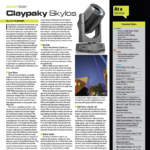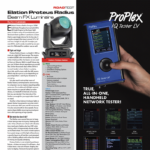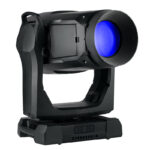Elation has released the first member of its Artiste line, their new series of white LED engine sourced fixtures. The DaVinci is a medium-sized spot fixture that packs quite a punch and comes with more functions than any fixture this size should be allowed. In other words, it’s pretty much covering every function a hard-edge fixture should, from an animation wheel to color mixing to frost filters. They didn’t skimp on anything. The big question is — how did they pack all of this in such a condensed and lightweight package?
It was nice to receive a cardboard box where I alone could remove a fixture, since it weighs a mere 56 pounds. Twin handles on the base make for easy carrying. I connect the PowerCON TRUE1 to Edison AC plug (there is an in and an out for daisy chaining) and applied 110 volts. It homes quickly and takes me under a minute to work the LCD display, address the fixture, choose the extended personality today, as well as choose a dimmer curve (the default linear one).

The Beam
With no bulb to strike, I’m instantly looking at a cool white light output of 7500° emitted from a fixture via its 290-watt light source. I measure almost 14,000 lumens out of the front. From a distance of 30 feet in a tight zoom, I read 500 foot candles on my meter. This is equivalent to a Martin MAC 700 or a Vari-Lite VL2500 in brightness.
The beam projects a perfectly flat field with a crisp edge when the zoom and focus are defaulted at 50 percent, as it should be. The dimming is perfectly smooth to the eye as there is no mechanical shutter, just the fader controlling the output from the white source. They have different dimming curves that allow the end user to determine the attack and decay rates they wish, per the type of performance. They provide different curves for stage, TV, architecture and theater use. I did not test them.
The various strobe effects produced from this light are quite good. One has the usual electronic sync and random strobe rates. They added in a pulse strobe rate as well that is a great programming tool. I noticed they have a fast-spinning gobo wheel as well as an animation wheel that goes a bazillion revolutions per second. These give me what I refer to as “gobo-strobe” effects. Dependent on the speed, one can make the fixture flicker like an old 8mm projector.
The zoom is smooth and incredibly fast, ranging from six to 48 degrees. It can be used in a sine wave for a great effect. Also included is a variable frost that is also fast enough to be used as an effect.
Lastly, they somehow squeezed an iris into the path of light. This reacts differently than any light I have seen in that, as it closes, the beam edges become softer and the light fades out as it closes.
It’s reminiscent of the old Vari-Lite fixtures where you could close the beam by shutting the iris all the way if you wished. I would prefer a smaller crisp white beam, but I do like some of the onboard iris effects I see, such as the pulsing one.
The light goes into hibernation mode when at zero intensity. There is no light output leaking anywhere, which is sweet. My camera notices zero flickering from the beam. Lastly, after being on for two hours at full intensity, the fixture is warm, but not hot. The fans in the base and back of the fixture do keep it cool.

Movement and Color
A fixture of this size has no right to move as fast as this yoke does. I tilt 270° in 0.7 seconds. It pans 540° in double that time. Its smooth 16-bit movement works awesome in any effect I put it in. It executes big circles quickly and flawlessly. The torque the motors on this fixture have is unbelievable. To kick a light out of its pan and tilt focus requires a lot of strength. Even after I do that, the fixture returns to its dedicated focus position.
The fixture contains a CYM system and a color wheel with seven replaceable filters. The color wheel is set up perfectly, with the red and no color slots adjoining and the blue and green dichroics positioned next to each other. Like everything else in this fixture, you can snap between colors. The CYM mixing system executes effects engine sine waves and color snaps smoothly and as fast as anything on the market. This color system is baffling me, but in a good way. I’m mixing solid orange and amber colors that are not a mix of several hues of red and yellow. I’m looking at a perfect amber color coming out of the fixture, something I doubt I’ve ever seen through mixing CYM flags. Well done Elation, however you accomplished this.
I cannot mix a saturated blood-red color; a fire colored hue is as good as it gets. The green, on the other hand, is exquisite and excellent at not taking away all the light output. I can mix lavenders and a Congo blue that is acceptable. The deep blue color is sexy and vibrant.
There is also a variable CTO filter in the fixture. When that’s at full, I do not see an orange-based false CTO hue, just the brown look of a tungsten source, as I should. There are built-in color macros, which basically are premixed colors that the fixture provides. This includes an onboard random CYM chase effect.
The Effects
There is a single gobo wheel with six interchangeable rotating glass gobos. These perform as they should. Some are new and some are standard recognizable patterns such as the single bar. Half make good textures, half make good aerial patterns. There is a static gobo wheel, but unlike everyone else’s stamped models, these nine gobos are all interchangeable. The stock gobos on this wheel are also a varied mixture, but I find them all appealing. The shake function works on both wheels as does the bidirectional continuous spin. I see one can shake and rotate the gobos at the same time.
There is an auto focus channel on the fixture. When activated, the fixture knows the programmer is wishing for a sharp-edge gobo regardless of the zoom adjustment. It performed flawlessly. When that channel is at zero, the user can soften their focus manually for texturing scenery.
Some prism effects are included, and the 3-facet and linear rotating types perform as expected. Somehow, they snuck a bi-directional animation wheel in this fixture. Although it rotates continuously, you cannot choose between vertical or horizontal lines on the effect. But I’m okay with that for a fixture this size.
I ran this light in 40-channel extended mode, but if I was programming a show, I would be quite happy with the 28 channel standard mode or even the basic one. I can control it via DMX and the typical 5-pin XLR in/out connections. It can also accept RDM. Art-NET and sACN protocols via a RJ45 Ethernet in/out are available and can be used too. The DaVinci comes with an Elation E-Fly Wireless DMX Transceiver.
At a Glance
Compact, Lightweight, Quick and Versatile
A great addition to the Elation line, the DaVinci is a compact, stealthy-looking fixture that offers up 470 maximum watts of power. Its white LED light source will last you the life of the fixture, one would speculate. It offers all the bells and whistles found in any hard-edge fixture, other than framing shutters.
Elation Artiste DaVinci
PROS: Fast movement, quick zoom, smooth dimming, electronic strobe effects. CYM color system in a compact fixture.
CONS: Beam cannot retain a hard edge when iris is closing.
FEATURES:
- Full CMY Color Mixing w/ Linear CTO Color Correction
- 7 Dichroic Colors including CTB and Violet
- 6 Rotating and 9 Static-Stamped Interchangeable Gobos
- 3-Facet and Linear Rotating Prisms and Frost Filter
- Full 360° Bi-Directional Animation Wheel
- High Speed Electronic Shutter and Strobe
- Motorized Iris, Focus, and Auto-Focus
- Variable Dimming Curve Modes
- DMX, RDM, Art-NET, and sACN Protocol Support
- Elation’s E-FLY Internal Wireless DMX Transceiver
- Low Heat, Quiet Operation, Hibernation Mode
- Adjustable LED Refresh Rate Frequency and Gamma
- Flicker Free Operation for Broadcast TV and Film
SPECS:
- Size: 16.4 x 11.2 x 25.4”
- Weight: 56 lbs.
- Lamp Source: 270W cool white LED engine
- Wattage: 470W max
- Zoom Range: 6° to 48°
- Color: CYM and color wheel
- MSRP: $6,500
- Manufacturer: Elation Professional
More Info: www.elationlighting.com



